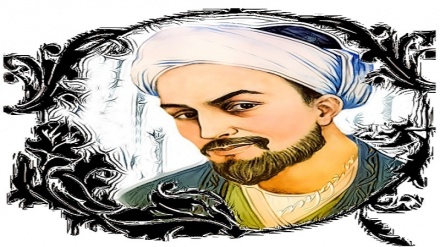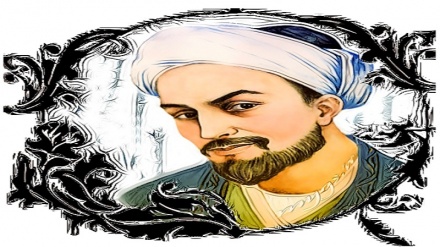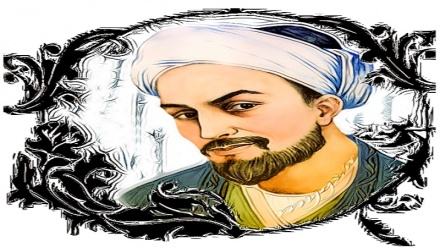Iranian notables, sources of global honor (198)
As a reminder, it was said that Fakhruddin Eraqi was a prominent Muslim mystic and poet of Farsi language in the 7th century AH (13th century AD) who was born in Komjan village of Hamedan Province.
It was also said that he learnt the Qur’an by heart in 9 months at the age of 5. At the age of 17, Eraqi was a master of all sciences of the day and started teaching in the city of Hamedan. Very soon he left Hamedan for Multan in the Subcontinent to join the pupils of the renowned mystic of the time, Sheikh Baha’uddin Zakaria. Then, he reached a degree in mysticism that Sheikh Zakaria gave his own cloak to Eraqi and he became one of the prominent students of the Sheikh. Later on, he traveled to Mecca, and left there for Konia in today’s Turkey to attend the class of Sheikh Sadruddin Qunavi. Thus, he stayed in Konia till 675 AH when he went to Egypt and then Syria to stay in Damascus till the end of his life. It is said that Eraqi succumbed to a painful and fatal disease when he was 78 or 82 years old. He was buried at Jabal al-Salihiya behind the tomb of Muhyiddin ibn Arabi. Fakhruddin Eraqi has authored several books. We have already discussed his work Loma’at and today we will continue the discussion.
Cognizance is one of the important subjects of Fakhruddin Eraqi’s book Loma’at. The pivot and core of Islamic mysticism is cognizance; cognizance of God; it means knowing God. Qushairi, in his book “Resale-ye Qushairiyeh” (Qushairiyeh Treatise), says that cognizance (Ma’rifat in Arabic) is a branch of knowledge in the view of ulema; and he who knows God is a mystic (Gnostic). Qushairi maintains that cognizance is the characteristic of those who know God through His names and attributes. Cognizance is so important in the Islamic mysticism that most of the books written by great mystics contain a chapter on the issue. The reason for this much of attention to cognizance stems from the noble Qur’an. God has said in the Qur’an that cognizance of Him is the ultimate goal of creation. Most of the mystics believe that cognizance is a merit that is achieved by the heart. Eraqi maintains that man, universe and God form the three main pillars of cognizance. In the book Loma’at, it is said that the degrees of cognizance are related to the degrees of existence; and existence is nothing but the absolute truth of Almighty God which is the Source and Beginning of the whole creation.
Human being is a combination of dust and spirit, or in the words of mystics, light and darkness. Self-cognizance is one of the very important issues in mystic works. A review of the works of mystics shows that the purpose of self-cognizance is to know the spirit and its capabilities. Mystics have talked on this extensively in their works and everyone has tried to explicate in one way or another. For instance, Azizuddin Nasafi in the book “al-Insan ul-Kamel” (Perfect Man) says that there is no limit for sublimation of man’s spirit and summarizes his perfection in four categories: righteous words, righteous deeds, righteous ethics and cognizance. He continues that cognizance means knowing and it has three aspects: cognizance of this world, cognizance of the Hereafter, cognizance of the self and cognizance of the Lord (God). Eraqi, too, opines that self-cognizance is very important whereby man can know the world, the Hereafter and God. Eraqi also maintains that man will face many barriers on the way of reaching cognizance; and that he should remove them in order to reach the absolute truth which is God. He has discussed this in detail in the 12 part of Loma’at.
Fakhruddin Eraqi believes that traveler toward God (Salek), through austerity and purification of the spirit, can removes 70 thousand barriers. He uses two terms to describe these barriers: luminous barriers and dark barriers. He says that dark barriers, including ignorance, conjecture and moral vices hinder the way of cognizance of truth. He is of the opinion that a mystic, with painstaking efforts, tries to repel these dark barriers and reach God via His cognizance; but, luminous barriers, like knowledge and certitude, prevent him. Eraqi believes that the only way to reach cognizance is to empty the heart from the dark barriers and dust that block his way. He mentions a proverb to emphasize that the way of cognizance of God and monotheism passes through self-cognizance. He maintains that if the traveler, with the help of love, covers the degrees of spiritual journey and removes the barriers one after the other, he becomes certain that he should seek God in his inward. Accordingly, he concludes that, “Anyone, to whom this door is opened, sits at the existence of his non-existence and sees himself and the Beloved reflected in the mirror of one another.”
Thus, he says that the more purified the heart, the more he will achieve cognizance and the more God will be manifested in his heart. He believes that man will know himself after reaching the stage of being a mirror. Thus, duality will perish and the traveler (who is the perfect man now) will be united with the Beloved (God).
Fakhruddin Eraqi opines that the universe is the manifestation of God and the world and whatever is there in it are showing God like a painting. He strongly believes that in every minutest particle of the universe there is a way to the Creator and the Absolute Existence.
Every shape seen on the board of universe,
is the image of the One who has formed it.
When the old sea becomes wavy,
It is called wave, while it is the sea.
Eraqi stresses in the book Loma’at that the traveler of the way of God has to purify his spirit to get to know the universe and he has to seek help from love in this way. He believes that the light of God is everywhere in the universe and everywhere we can see it. In his opinion, if we open the eyes of the heart, we can see the beauties of God everywhere.
RM/ME


